
Guests
- Graham Bowleyreporter for the New York Times in Kabul, Afghanistan.
- Nancy YoussefMcClatchy’s chief Pentagon correspondent. Her coverage focuses on the wars in Iraq and Afghanistan.
Links
- Read Nancy Youssef in McClatchy
- "U.S. Soldier to be Tried in Afghanistan Massacre." By Nancy Youssef (McClatchy, March 12, 2012)
- "An Afghan Comes Home to a Massacre." By Taimoor Shah and Graham Bowley (New York Times, March 13, 2012)
- Follow Graham Bowley on Twitter: @graham_bowley
- Follow Nancy Youssef on Twitter: @nancyayoussef
- A decade of Democracy Now! reports on the war in Afghanistan
- Read Graham Bowley in the New York Times
As President Obama vowed to “spare no effort” to fully investigate the Afghan massacre, we go to Kabul to speak with Graham Bowley of the New York Times for the latest. On Tuesday, hundreds of students in eastern Afghanistan protested against the United States. Many called for an end to the U.S. occupation in their country. Bowley has reported on the surviving relatives of victims of the Afghan massacre, including Abdul Samad, who lost his wife, four daughters, four sons and two other relatives. “This is a very war-torn area and very poor,” Bowley says. “During the surge in 2009, the coalition forces swept through this area and destroyed many of the villages… [Displaced residents] didn’t want to come back, but they were drawn back under the urging of the Afghan government… Abdul Samad and other people came back to this town… It was only just over a mile from the camp where the American soldier was stationed. And he thought it was going to be safe.” We also speak with Nancy Youssef, McClatchy’s top Pentagon correspondent, who compares the massacre in Afghanistan with the U.S. killings of 24 Iraqi civilians in the Iraqi town of Haditha in 2005. [includes rush transcript]
Transcript
AMY GOODMAN: Afghan authorities say they have viewed surveillance video of the U.S. Army staff sergeant accused in shooting 16 Afghan villagers. The video reportedly shows the soldier walking up to his base and raising his arms in surrender. U.S. officials say the video helps show only one perpetrator was involved in the Sunday shooting. Nine children and three women are among the dead. Some of their bodies were apparently burned.
In a White House address Tuesday, President Obama promised to, quote, “spare no effort” to fully investigate the deadly shooting rampage.
PRESIDENT BARACK OBAMA: The United States takes this as seriously as if it was our own citizens and our own children who were murdered. We’re heartbroken over the loss of innocent life. The killing of innocent civilians is outrageous, and it’s unacceptable. It’s not who we are as a country, and it does not represent our military. And for that reason, I’ve directed the Pentagon to make sure that we spare no effort in conducting a full investigation. I can assure the American people and the Afghan people that we will follow the facts wherever they lead us, and we will make sure that anybody who was involved is held fully accountable with the full force of the law.
AMY GOODMAN: Meanwhile, Defense Secretary Leon Panetta has arrived in Afghanistan on an unannounced trip that is the first visit by a senior member of the Obama administration since the massacre.
DEFENSE SECRETARY LEON PANETTA: War is hell. These kinds of events and incidents are going to take place. They’ve taken place in any war. They’re terrible events. And this is not the first of those events, and it probably won’t be the last. I do not believe that there is any reason at this point to make any changes with regards to our strategy and for the process of drawing down.
AMY GOODMAN: Despite official disavowals of the shootings, yesterday hundreds of students in eastern Afghanistan protested against the United States. Some students burned an effigy of President Obama and blocked the main highway to Kabul. Many called for an end to the U.S. presence in Afghanistan. This is protester Dadullah Khan.
DADULLAH KHAN: [translated] We don’t want any strategic partnership with the foreign troops. Afghans are independent people. We want to live independently, and we don’t want to live under any country’s colonization. So, once again, we condemn the Kandahar incident with the strongest words and urge the authorities to put the criminal to trial.
AMY GOODMAN: Elsewhere in Afghanistan, suspected insurgents fired on an Afghan government delegation investigating the massacre of the 16 civilians. Two of President Hamid Karzai’s brothers were with other senior officials when insurgents opened fire.
Meanwhile, more details are emerging about the alleged shooter, a 38-year-old Army staff sergeant of the 3rd Stryker Brigade Combat Team from Joint Base Lewis-McChord in Washington state. He was trained as a sniper, served three tours in Iraq before arriving in Afghanistan late last year. In 2010, he was reportedly treated for traumatic brain injury suffered in a vehicle rollover in Iraq. Afghan lawmakers have called on the soldier to be put on trial inside Afghanistan. He could face the death penalty
For more, we go to Kabul, Afghanistan, to speak with New York Times reporter Graham Bowley.
Welcome to Democracy Now!, Graham. You have written a story about the victims’ family. Can you talk about exactly where this took place and who the people were who were killed?
GRAHAM BOWLEY: Yeah, thank you. We focused on the villagers, and we interviewed people who had been there during the attack and the survivors, and we pieced together what had happened. This was in a very poor area of Kandahar province in the south of Afghanistan, a sort of grape-growing area, which suffered tremendously during the surge in 2009, and many people fled around the province into Kandahar city. And then they came back about a year ago. And we talked to Abdul Samad, a 60-year-old grape farmer, very poor, who moved back, with the encouragement of the U.S. government, the Army, and the Afghan government. And he moved into a mud-bricked house very close to the base, and he thought he would be safe because he was close to this base, the American base.
He went out on Saturday night to a nearby town, and while he was coming back in a taxi, he got a call that it was an American soldier, the staff sergeant, who had walked out from the base and attacked his house. And he lost 11 family members. He was in the first village where the American soldier attacked. He then left and went on to a second village, where he attacked two more houses, killing some in the first house and one in the third house. What was truly horrifying about Abdul Samad’s experience, he lost his wife and eight children and two other family members. The soldier, after this massacre, appears, anyway—there were stab wounds on the bodies, many people told us—and he gathered the bodies together, these people said, and burned them—the soldier—before leaving. So it was a particularly gruesome and horrifying event. And my colleague, Taimoor Shah, interviewed him in Kandahar. It was too dangerous for us to go there. But he interviewed him outside the base where Abdul Samad, this old man, who was very distraught, of course, had brought the bodies of his children and his wife in a van to just sort of show them to the camp in his despair.
AMY GOODMAN: So, Abdul Samad lost four daughters between the ages of two and six, four sons between the ages of eight and 12. And Graham, can you explain more why Abdul Samad had gone back to live near a U.S. military base, since he, like so many Afghans, had been displaced?
GRAHAM BOWLEY: Well, this is a very war-torn area and very poor. He had left during the surge when the coalition troops had fought the Taliban. This is Taliban heartland, where the Taliban was born and was very powerful. And during the surge in 2009, the coalition forces really swept through this area and destroyed many of the villages. His own house was destroyed. In some cases, forces would just wipe out whole villages, because they were so booby-trapped and so dangerous. So people fled. And they didn’t want to come back, but they were drawn back under the urging of the Afghan government. You know, they were trying to rebuild this area, and they wanted to go back to their homes. And the people we spoke to showed this great reluctance to do this, this great hesitation, and many didn’t. They stayed in Kandahar.
But Abdul Samad and other people came back to this town. And some of the houses had been rebuilt. And he moved into a new—sort of a relatively new house, and he believed it was safe, because it was very close. It was only just over a mile from the camp where the American soldier was stationed. And he thought it was going to be safe. And indeed, the Taliban had been driven out, although the villagers we spoke to described this sort of intolerable life where now the Taliban is sort of moving back, and every day there are mortars being fired from the base, mortars being fired back. There are land mines where U.S. troops are being targeted continually. It’s sort of this sort of mind-numbingly horrific life that they lead.
AMY GOODMAN: Graham, you and Taimoor Shah write that Mr. Samad said, “Our government told us to come back to the village, and then they let the Americans kill us.” This was a person who was somewhat sympathetic to the U.S. military, actually thought he would be safer there with all of his family. Talk about what he and others are now saying in the aftermath of the killings.
GRAHAM BOWLEY: Well, this story was important for us, because it’s sort of emblematic of a kind of a breaking of trust, which you can feel at the moment here. It does seem to be sort of a new sense about the place. It started with the Koran burnings. And these things go in cycles. There have been horrific things in the past. We had the Koran burnings, which was amazing outrage, a few weeks ago, and, you know, people running through the streets behind me. And then this time there’s been this sort of knee-jerk anger. And you can talk to people, sort of people who are saying, you know, “How can this be? Why would Americans do this? Is this typical of every American?”
But having said that, there’s then a sort of secondary reaction in most people. There were protests yesterday in Jalalabad, but they were quite small, actually. And there’s been violence down in Kandahar yesterday and today, but that’s the Taliban, it seems. But the secondary reaction is—is sort of more measured and limited. And most Afghans, certainly the ones I’ve been talking to, know that they want the coalition forces here. And many people actually are in denial. They can’t believe that America is going to leave in 2014. And they know that if they do, they know what a disaster it will be for their lives.
AMY GOODMAN: On the issue of the Koran burnings, Graham Bowley of the New York Times who’s speaking to us in Kabul, you have investigated this. The investigation into them was stalled. How did this happen?
GRAHAM BOWLEY: The Koran burnings?
AMY GOODMAN: Yes. How did the Koran burnings happen?
GRAHAM BOWLEY: Well, the investigation is—
AMY GOODMAN: How did the U.S. soldiers burn the Koran?
GRAHAM BOWLEY: We think—you know, my colleague, Alissa Rubin, wrote a great story a few—a week ago about the kind of chain of events by which it occurred. And there’s an investigation underway under ISAF. The NATO coalition here is conducting that investigation, and they’re going to report soon. And then, at the end of the month, they’ll give a full explanation, probably, and some sort of recommendations.
But it seemed to be sort of a chain of errors, errors that aren’t excusable, because, you know, the people at the camp—it was at Bagram, not far from Kabul, the kind of main—these Korans were taken from prisoners. There was writing in the Korans, which seemed to be messages—that was the suspicion—being passed by insurgents, and so, therefore, a safety risk. And so, the Korans were taken away and stored. And the people that took them away sort of knew they wouldn’t—they shouldn’t be damaged. And they were stored. But then, over the next days, they were then taken away and taken to an incinerator, and they were thrown in. And there were a number of sort of checks along the way where it should have been stopped, it seems. We don’t know the full story yet, and we will soon, we hope, when NATO—when General John Allen finally gets the report and talks about it. But I think they’ve identified four or five servicemembers who were responsible in that sort of chain, and they face some sort of punishment. We don’t know what it is.
AMY GOODMAN: And the long-planned trip of Leon Panetta, his—the response to his arrival now in Kabul, Afghanistan? Of course, the first U.S. official to be coming there, high-level administration official, since the—since the attack took place.
GRAHAM BOWLEY: That’s true. He’s here at this very tense moment. You know, all things are up in the air. There’s a lot at play. There’s the talks with the Taliban, and then there’s sort of America trying to work out why is it here, and how long should it be here, and really how fast can it get out, and what sort of Afghanistan will it leave behind it. And there’s questions about the Koran burnings and then this terrible shooting plays into that, with sort of diplomatic ramifications.
But what I would say is one interesting point, which is sort of occupying as is how little—the little outrage there has been. There hasn’t been the people on the streets that we did see with the Koran burnings. You know, everybody’s acting with complete horror. But we think that probably the reason it is, is it’s sort of a resignation. These things happen a lot. Children die a lot in Afghanistan, especially in this war. And so, you know, we’ve been asking this question: why aren’t people on the streets? And, you know, it’s a terrible war, and people are almost used to it now.
AMY GOODMAN: I wanted to bring Nancy Youssef into this conversation. She is the chief Pentagon correspondent for McClatchy’s, used to be in Iraq. She covered Haditha, the 2005 massacre in which 24 innocent Iraqi civilians, men, women and children, were killed. Nancy Youssef, when you go from that to what you’re seeing today, can you talk about parallels in—from Haditha to what has taken place in Afghanistan?
NANCY YOUSSEF: Well, I think the most obvious parallel is that there’s—that it’s a horrific event that really sort of raises questions in a very public way about the U.S. mission in these war zones, whether they’re bettering or worsening their position. That is, if the campaign is to win hearts and minds, and events like this happen, it certainly raises questions about whether the U.S. effort is—is, in fact, rather than winning hearts and minds, creating new enemies.
The biggest difference, though, is that in Haditha, it was during a military operation, where this appears to be someone who acted out on his own and against every order, violating one rule after another in carrying out this act. And so, they’re both defining moments in terms of the campaign and the U.S. effort and whether it’s going in the right way or not. They, in a way, sort of capture all the challenges. But I think the fact that one was carried out, in the case of Iraq, during a military operation, this seemingly by sort of a lone person, I think, I think is an ultimate important distinction.
AMY GOODMAN: I wanted to bring that issue up of the lone soldier, Graham Bowley, in Kabul. Many Afghans are saying, and people in the area are saying, they saw other soldiers, questioning whether in fact this was just one lone soldier. What have you heard along these lines, Graham?
GRAHAM BOWLEY: Yeah, talking to people down there, you know, we spoke to 30, 40, 50 people in these villages. And neighbors who kind of rushed to the scene and saw the burning bodies, people who kind of survived the attack, they saw—they swear they saw more than one soldier. And there’s this great sort of divide between what the coalition, the American-led coalition, is saying, that it was just one soldier, just one soldier, and what the people down there are saying. And the Americans’ position is sort of increasing the anger. But one explanation, we think, might be that soldiers and helicopters were sent out after the attack, after he had given himself up. And the military tell us that they did take helicopters, and they picked up the injured people. There were at least five people injured, as well, and taken to the military hospital. So there’s a lot of confusion. It was very dark. You know, it was early in the morning. And that may explain it.
AMY GOODMAN: And the latest news that’s coming out—and I’d like to ask Graham and then Nancy about this, about who this soldier was. We don’t know his name. The only information, of course, that’s coming out is information from the military, that he might have suffered a traumatic brain injury in Iraq in a vehicle rollover. Now they’re saying there may have been alcohol involved. And it’s interesting how things are framed, you know, the idea of tragedy versus terrorist, depending on whose side you’re on, for what this means. Graham, let’s start with you in Kabul, Graham Bowley of the New York Times.
GRAHAM BOWLEY: Yeah, we’re all waiting to know, Amy, who this person was and his background and perhaps any explanation. We know that he was—he served three times in Iraq, and then he—this was his first tour in Afghanistan. And we know that he was in this very dangerous part of the country, you know, as I described, this sort of life of attacks where the Taliban are laying these IEDs continually and where, you know, Americans die regularly. So, we’d like to know, from that point of view, you know, why he did it. From the Afghan point of view, though, you know, any suggestion that it may have been because he was ill or, you know, any sympathy for him is sort of dangerous. They want justice. And as you said, parliament’s sort of very strong words demanding that he’s put on trial here, which is very unlikely. But, you know, playing out this story and getting to the truth, of course, but being aware that, as you said, very cleverly, there are sort of two sides, and it will kind of touch nerves, how it’s presented.
AMY GOODMAN: Nancy Youssef, the charging of this man and what this means, people in Afghanistan calling for him to be tried in Afghanistan? Nancy, if you could tell us what they’re talking about at the Pentagon?
NANCY YOUSSEF: Well, they’ve talked about charges. He will be in Afghanistan when he presumably is charged under the Uniform Code of Military Justice. Secretary of Defense Leon Panetta suggested death—that he could face the death penalty, which tells us that it appears that he’ll be charged with premeditated murder, which carries the death penalty with it. We’re still waiting for those charges. And we expect that at that time we will know who the soldier is.
I think the other interesting thing to point out in his background is the base that he came from, which is in Fort Lewis, Washington, which is also the home of the 5th Brigade, 2nd Infantry Division, which you’ll remember last year was charged with committing crimes against Afghans, taking body parts as war trophies. And I think, for us at the Pentagon, that raises questions about whether there’s some sort of command problem at that military installation that’s contributing to these acts. So I think that’s something that also is being looked at from Washington.
AMY GOODMAN: You’re talking about what became known as the “kill team.”
NANCY YOUSSEF: That’s right. That’s right. And they’re both from the same military installation. But as Graham pointed out, there also—they also both served in a very dangerous, very volatile part of Afghanistan. So—but broadly, there is a question of command. Is there—from a military perspective, if there’s a command problem out of Fort Lewis, and broadly, in Afghanistan, given that this is the third event in a matter of weeks where there has been some sort of command problem.
AMY GOODMAN: Nancy Youssef, I know you have to race off to the Pentagon. I thank you very much for being with us from McClatchy Newspapers. Graham Bowley, New York Times in Kabul, how do you keep yourselves and your colleagues safe? I mean, a threat issued that any American would be beheaded—is this real? Is this more being played up in the United States?
GRAHAM BOWLEY: No, it’s a tense time, Amy. Our travel has been restricted, as has people in the embassies and in the camps around here. And there’s lots of people here trying to rebuild the country, working for the aid groups, building bridges all over the country, roads. And, you know, since the six Americans were shot, soldiers were shot, during the Koran riots, there’s this new sense of worry and that outsiders could be a target.
AMY GOODMAN: And in terms of keeping Afghans safe, this question of when the U.S. military will pull out, what is your sense now? Has that schedule been accelerated, given everything from the U.S. soldiers urinating on the Afghan corpses to the burning of the Korans, now to this massacre?
GRAHAM BOWLEY: I think it is. I think there’s certainly discussions. We reported on it yesterday, that an accelerated timetable is underway, and when will the extra troops from the surge start to go home. But as I said, Afghans themselves don’t really get it. They’re very scared about the consequences and the positioning of sort of neighboring countries and people within the country itself, which is sort of very fractionalized between the north and different groups in the north and the south, and then there’s the Taliban, and, you know, is it waiting just to kind of sweep back into the country once America withdraws.
The main mission at the moment of the troops here, you know, is one of security, is training and the training mission, the attempt to build up Afghan forces so that they are capable to look after themselves and look after the country and look after Afghans. And that’s under the way—underway at the moment. But there is the sense that it’s a very hasty project, and it’s not clear whether the standards are high and whether indeed they’ll have the resources to pay for this force once America and its money goes away. Aid money accounts for—last year accounts for about 97 percent of this country’s gross domestic product. It’s a big part of the economy. And you get a kind of sense of a sucking sound as it withdraws. There’s some hope that things like natural resources will take the place and provide some sort of government revenue for the government here in Kabul, which can then sort of filter out into the country and pay for the security. But it’s certainly not clear.
And there’s a new deadline coming in about two weeks, where President Karzai, in the interest of sovereignty, has abolished private security groups here. Sort of about 20,000 people that currently work for international groups will go straight to the Ministry of Interior and be employed by them. And there’s great uncertainty here in Kabul and around the country about, you know, what sort of controls are in place. What will these people be? Will they be anything more than militia, you know, that could be—kind of go to the highest bidder? Or will it be sort of a kind of a sensible transition that this country is taking as it steps forward and tries to stand on its own?
AMY GOODMAN: Graham Bowley, I want to thank you for being with us in Kabul, Afghanistan, correspondent for the New York Times.
This is Democracy Now!, democracynow.org, The War and Peace Report. When we come back, we’re going to look at that base, Fort Lewis-McChord, and also look at the issue of how soldiers are treated when they come home—for example, their mental health treatment. What happens if you have traumatic brain injury? This is Democracy Now! We’ll be back in 30 seconds.


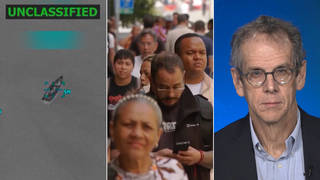
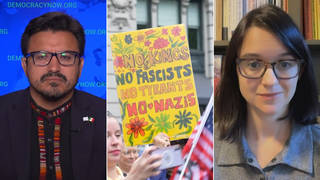
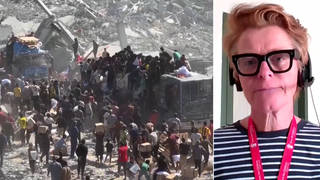





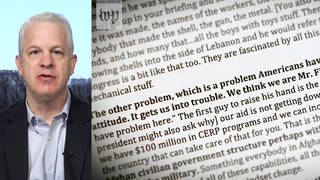
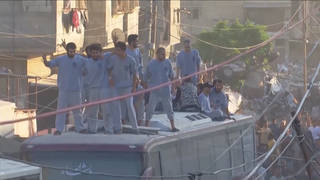
Media Options